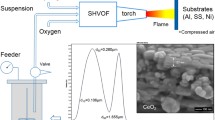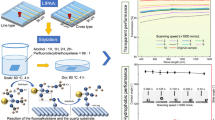Abstract
Robust superhydrophobic surfaces can improve the performance of various applications. Considerable research has focused on developing superhydrophobic surfaces, but in these studies, superhydrophobicity was attained using polymeric materials, which deteriorate under harsh environments. Recently, it has been shown that rare-earth oxide ceramics are hydrophobic and since they are ceramics, they withstand harsh environments including high temperature. Here we fabricate a superhydrophobic surface by texturing a ceria pellet using laser ablation. We demonstrate water repellency by showing an impinging water droplet bouncing off the surface. This study extends the possibility of producing robust superhydrophobic ceramics using accessible techniques for industrial applications.



Similar content being viewed by others
References
D. Quere: Wetting and roughness. Annu. Rev. Mater. Res. 38, 71 (2008).
X. Feng and L. Jiang: Design and creation of superwetting/antiwetting surfaces. Adv. Mater. 18, 3063 (2006).
H. Rathgen and F. Mugele: Microscopic shape and contact angle measurement at a superhydrophobic surface. Faraday Discuss. 146, 49 (2010).
L. Bocquet and E. Lauga: A smooth future? Nat. Mater. 10, 334 (2011).
X. Deng, L. Mammen, H.J. Butt, and D. Vollmer: Candle soot as a template for a transparent robust superamphiphobic coating. Science 335, 67 (2012).
C.J. Bird, R. Dhiman, H.M. Kwon, and K.K. Varanasi: Reducing the contact time of a bouncing drop. Nature 503, 385 (2013).
S. Srinivasan, W. Choi, K.C. Park, S.S. Chhatre, R.E. Cohen, and G.H. McKinley: Drag reduction for viscous laminar flow on spray-coated non-wetting surfaces. Soft Matter 9, 5691 (2013).
I.U. Vakarelski, N.A. Patankar, J.O. Marston, D.Y.C. Chan, and S.T. Thoroddsen: Stabilization of leidenfrost vapour layer by textured superhydrophobic surfaces. Nature 489, 274 (2012).
B. Bhushan and Y.C. Jung: Natural and biomimetic artificial surfaces for superhydrophobicity, self-cleaning, low adhesion, and drag reduction. Prog. Mater. Sci. 56, 1 (2011).
N.J. Shirtcliffe, G. McHale, M.I. Newton, and Y. Zhang: Superhydrophobic copper tubes with possible flow enhancement and drag reduction. ACS Appl. Mater. Interfaces 1, 1316 (2009).
T. Maitra, M.K. Tiwari, C. Antonini, P. Schoch, S. Jung, P. Eberle, and D. Poulikakos: On the nanoengineering of superhydrophobic and impalement resistant surface textures below the freezing temperature. Nano Lett. 14, 172 (2014).
P. Eberle, M.K. Tiwari, T. Maitra, and D. Poulikakos: Rational nanostruc-turing of surfaces for extraordinary icephobicity. Nanoscale 6, 4874 (2014).
P. Guo, Y. Zheng, M. Wen, C. Song, Y. Lin, and L. Jiang: Icephobic/ anti-icing properties of micro/nanostructured surfaces. Adv. Mater. 24, 2642 (2012).
C. Antonini, M. Innocenti, T. Horn, M. Marengo, and A. Amirfazli: Understanding the effect of superhydrophobic coatings on energy reduction in anti-icing systems. Cold Reg. Sci. Technol. 67, 58 (2011).
L. Mishchenko, B. Hatton, V. Bahadur, J.A. Taylor, T. Krupenkin, and J. Aizenberg: Design of ice-free nanostructured surfaces based on repulsion of impacting water droplets. ACS Nano 4, 7699 (2010).
A.J. Meuler, G.H. McKinley, and R.E. Cohen: Exploiting topographical texture to impart icephobicity. ACS Nano 4, 7048 (2010).
J. Lv, Y. Song, L. Jiang, and J. Wang: Bio-inspired strategies for anti-icing. ACS Nano 8, 3152 (2014).
S. Jung, M. Dorrestijn, D. Raps, A. Das, C.M. Megaridis and D. Poulikakos: Are superhydrophobic surfaces best for icephobicity? Langmuir 27, 3059 (2011).
D. Torresin, M.K. Tiwari D. Del Col, and D. Poulikakos: Flow condensation on copper-based nanotextured superhydrophobic surfaces. Langmuir 29, 840 (2013).
N. Miljkovic, R. Enright, Y. Nam, K. Lopez, N. Dou, J. Sack, and E.N. Wang: Jumping-droplet-enhanced condensation on scalable superhydrophobic nanostructured surfaces. Nano Lett. 13, 179 (2013).
S. Anand, A.T. Paxson, R. Dhiman, J.D. Smith, and K.K. Varanasi: Enhanced condensation on lubricant- impregnated nanotextured surfaces. ACS Nano 6, 10122 (2012).
N.A. Patankar: Supernucleating surfaces for nucleate boiling and drop-wise condensation heat transfer. Soft Matters, 1613 (2010).
C. Dietz, K. Rykaczewski, A.G. Fedorov, and Y. Joshi: Visualization of droplet departure on a superhydrophobic surface and implications to heat transfer enhancement during dropwise condensation. Appl. Phys. Lett. 97, 033104 (2010).
R.D. Narhe, M.D. Khandkar, P.B. Shelke, A.V. Limaye, and D.A. Beysens: Condensation-induced jumping water drops. Phys. Rev. E 80, 031604 (2009).
J.B. Boreyko and C.H. Chen: Self-propelled dropwise condensate on superhydrophobic surfaces. Phys. Rev. Lett. 103, 184501 (2009).
C. Dorrer and J. Riihe: Condensation and wetting transitions on micro-structured ultrahydrophobic surfaces. Langmuir 23, 3820 (2007).
T. Verho, C. Bower, P. Andrew, S. Franssila, O. Ikkala, and R.H.A. Ras: Mechanically durable superhydrophobic surfaces. Adv. Mater. 23, 673 (2011).
K. Liu and L. Jiang: Metallic surfaces with special wettability. Nanoscale 3, 825 (2011).
R.M. Wagterveld, C.W.J. Berendsen, S. Bouaidat, and J. Jonsmann: Ultralow hysteresis superhydrophobic surfaces by excimer laser modification of SU-8. Langmuir 22, 10904 (2006).
M.T. Khorasani, H. Mirzadeh, and Z. Kermani: Wettability of porous poly-dimethylsiloxane surface: morphology study. Appl. Surf. Sci. 242, 339 (2005).
N.J. Shirtcliffe, S. Aqil, C. Evans, G. McHale, M.I. Newton, C.C. Perry, and P. Roach: The use of high aspect ratio photoresist (SU-8) for superhydrophobic pattern prototyping. J. Micromech. Microeng. 14, 1384 (2004).
J. Drzymala: Hydrophobicity and collectorless floatation of inorganic materials. Adv. Colloid Interface Sci. 50, 143 (1994).
G. Azimi, R. Dhiman, H.-M. Kwon, A.T. Paxson, and K.K. Varanasi: Hydrophobicity of rare-earth oxide ceramics. Nat. Mater. 12, 315 (2013).
Y. Tian and L. Jiang: Intrinsically robust hydrophobicity. Nat. Mater. 12, 291 (2013).
L. Martínez, E. Román, J.L. de Segovia, S. Poupard, J. Creus, and F. Pedraza: Surface study of cerium oxide based coatings obtained by cathodic electrodeposition on zinc. Appl. Surf. Sci. 257, 6202 (2011).
K. Jiang: Fabrication and Catalytic Property of Cerium Oxide Nanomaterials. Ph.D. Thesis, University of Nebraska, Lincoln, 2011, Ch.2.
N.J. Lawrence, K. Jiang, and C.L. Cheung: Formation of a porous cerium oxide membrane by anodization. Chem. Commun. 47, 2703 (2011).
M.M. Gentleman, J.A. Ruud, M.I. Blohm, and M. Manoharan: Wetting resistant materials and articles made therewith. US Patent/US8062775 B2, 2011.
X. Wang, J.D. Shephard, F.C. Dear, and D.P. Hand: Optimized nanosecond pulsed laser micromachining of Y-TZP ceramics. J. Am. Ceram. Soc. 91, 391 (2008).
A.N. Samantand N.B. Dahotre: Laser machining of structural ceramics— a review. J. Eur. Ceram. Soc. 29, 969 (2009).
A.M. Kietzig, S.G. Hatzikiriakos, and P. Englezos: Patterned superhydrophobic metallic surfaces. Langmuir 25, 4821 (2009).
S.H. Kim, I.-B. Sohn, and S. Jeong: Ablation characteristics of aluminum oxide and nitride ceramics during femtosecond laser micromachining. Appl. Surf. Sci. 255, 9717 (2009).
A.Y. Vorobyevand C. Guo: Femtosecond laser nanostructuring of metals. Opt. Express 14, 2164 (2006).
A. Ben-Yakar, R.L. Byer, A. Harkin, J. Ashmore, H.A. Stone, M. Shen, and E. Mazur: Morphology of femtosecond-laser-ablated borosilicate glass surfaces. Appl. Phys. Lett. 83, 3030 (2003).
A. Kurokawa, K. Odaka, Y. Azuma, T. Fujimoto, and I. Kojima: Diagnosis and cleaning of carbon contamination on SiO2 thin film. J. Surf. Anal. 15, 337 (2009).
K.D. Kim, W.S. Tai, Y.D. Kim, S.-J. Cho, I.S. Bae, J.H. Boo, B.C. Lee, K.H. Yang, and O.K. Park: Change in water contact angle of carbon contaminated TiO2 surfaces by high-energy electron beam. Bull. Korean Chem. Soc. 30, 1067 (2009).
M.R.H. Knowles, G. Rutterford, D. Karnakis, and A. Ferguson: Micro-machining of metals, ceramics and polymers using nanosecond lasers. Int. J. Adv. Manut Technol. 33, 95 (2007).
Acknowledgments
We thank Professor Tonio Buonassisi for the use of the laser equipment. We are grateful for support from MIT Energy Initiative and DARPA Young Faculty Award.
Author information
Authors and Affiliations
Corresponding author
Rights and permissions
About this article
Cite this article
Azimi, G., Kwon, HM. & Varanasi, K.K. Superhydrophobic surfaces by laser ablation of rare-earth oxide ceramics. MRS Communications 4, 95–99 (2014). https://doi.org/10.1557/mrc.2014.20
Received:
Accepted:
Published:
Issue Date:
DOI: https://doi.org/10.1557/mrc.2014.20




